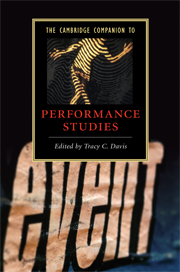Book contents
- Frontmatter
- Introduction: the pirouette, detour, revolution, deflection, deviation, tack, and yaw of the performative turn
- Part I Social polities: history in individuals
- Part II Body politics: the individual in history
- 7 Live and technologically mediated performance
- 8 Moving histories: performance and oral history
- 9 What is the “social” in social practice?: comparing experiments in performance
- 10 Live art in art history: a paradox?
- 11 Queer theory
- Further reading
- Index
9 - What is the “social” in social practice?: comparing experiments in performance
from Part II - Body politics: the individual in history
Published online by Cambridge University Press: 28 January 2009
- Frontmatter
- Introduction: the pirouette, detour, revolution, deflection, deviation, tack, and yaw of the performative turn
- Part I Social polities: history in individuals
- Part II Body politics: the individual in history
- 7 Live and technologically mediated performance
- 8 Moving histories: performance and oral history
- 9 What is the “social” in social practice?: comparing experiments in performance
- 10 Live art in art history: a paradox?
- 11 Queer theory
- Further reading
- Index
Summary
““In my innermost heart I am a Minimalist with a guilt complex.” - Santiago Sierra / “Touchable Stories began in 1996 with the idea of using the talents of contemporary artists to help individual communities define their own voice and give it public expression.”” - Shannon Flattery, Touchable Stories website (italics in original) / The above quotations come from two artists whose work differs enormously, yet both artists' work has been called “social practice.” As I noted recently in the “Lexicon” special issue of Performance Research, social practice is a term that has allegiances with a number of movements in experimental art and performance studies. Those allegiances bring to mind other terms that share some kinship with social practice: activist art, social work, protest performance, performance ethnography, community art, relational aesthetics, conversation pieces, action research, and other terms that signal a social turn in art practice aswell as the representational dimension of social and political formations. However, “social practice” is also embedded in a longer history of terms that have not always enjoyed triumphant celebration in the history of aesthetics: literal art, functionalist art, dumbed-down art, social realist art, victim art, consumable art, and related terms that have been coined to lament the capitulations to accessibility and intelligibility that can occur when art practice and social practice - aesthetics and politics - combine. How should we come to terms with this difference? Do the barometers for assessing aesthetic innovation differ so enormously from those that assess social innovation?
- Type
- Chapter
- Information
- The Cambridge Companion to Performance Studies , pp. 136 - 150Publisher: Cambridge University PressPrint publication year: 2008
- 4
- Cited by



